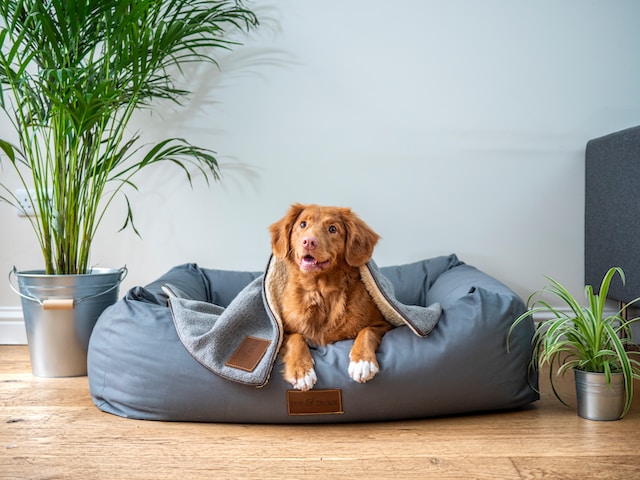As a pet owner, it’s natural to want to give your furry friend as much freedom as possible. But when it comes to allowing your dog to free roam the house, there are a few things to consider.
Why Free Roaming Your Dog in the House May Not Be a Good Idea
While it’s tempting to give your dog the freedom to roam around the house, it’s important to remember that dogs are natural explorers and can get into trouble if left unsupervised. Here are a few reasons why free roaming may not be the best idea for your pup:
Safety Concerns – Dogs can be curious and may chew on electrical cords, eat poisonous plants, or get into other dangerous situations when they’re left alone and unsupervised.
Destructive Behavior – Without proper training, some dogs may engage in destructive behavior like chewing on furniture or shoes, scratching doors or walls, or digging through trash.
House-Soiling – Puppies and untrained dogs may have accidents in the house if they’re not properly house-trained. This can cause damage to carpets and flooring, as well as unpleasant odors.
Separation Anxiety – Some dogs may experience anxiety when left alone, which can lead to excessive barking, destructive behavior, and other problems.
Boundaries and Training – Without clear boundaries and training, dogs may become confused about what behaviors are acceptable and what’s not. This can lead to inconsistent behavior and confusion for both the dog and the owner.
Training Your Dog to Free Roam the House
If you’re determined to allow your dog to free roam the house, it’s important to establish clear boundaries and train your dog to follow them. Here are a few tips to help you get started:
Gradual Introductions – Start by introducing your dog to one room at a time and gradually increase their access to other areas of the house as they learn to behave appropriately.
Crate Training – Crate training can be an effective way to teach your dog to stay in one area of the house while you’re away. A crate can also provide a safe and comfortable space for your dog to rest and relax.
Positive Reinforcement – Reward your dog for good behavior and ignore bad behavior. Positive reinforcement can be a powerful tool in training your dog to follow rules and boundaries.
Exercise and Stimulation – Make sure your dog gets plenty of exercise and mental stimulation to help prevent boredom and destructive behavior.
Consistency – Consistency is key when it comes to training your dog. Make sure everyone in the household is on the same page and reinforces the same rules and boundaries.
When Can You Let Your Dog Roam the House Alone?

The age at which you can safely allow your dog to roam the house alone depends on several factors, including the individual dog’s behavior and training, the size of the house, and the level of supervision available. Here are a few general guidelines to keep in mind:
Puppies – Puppies should never be left alone in the house until they’re fully house-trained and have learned appropriate behaviors. This can take several months or even up to a year.
Adolescent Dogs – Adolescent dogs may still be in the process of learning appropriate behaviors and may need more supervision and training before they can be left alone in the house.
Adult Dogs – Adult dogs who have been properly trained and have demonstrated good behavior can generally be left alone in the house for a few hours at a time. However, it’s important to continue to monitor their behavior and make adjustments as needed.
Is it Safe to Leave Your Dog Alone for 8 Hours?
Leaving your dog alone for 8 hours is generally acceptable for adult dogs who are well-trained and can handle being alone. However, it’s important to note that puppies and senior dogs may not be able to hold their bladder for that long and may need to be let out more frequently.
It’s important to make sure your dog has access to water and a comfortable place to rest while you’re away. Additionally, leaving toys or puzzles for your dog to play with can help keep them mentally stimulated and prevent destructive behavior.
If you’re concerned about your dog being alone for long periods of time, consider hiring a dog walker or pet sitter to come and give your dog some attention and exercise during the day.
Will my dog eventually stop barking when I leave?
Dogs who bark excessively when left alone may have separation anxiety, which is a common condition in dogs. While some dogs may eventually learn to stop barking when left alone, others may need additional training and behavior modification techniques.
It’s important to address separation anxiety as soon as possible, as it can lead to destructive behavior and other issues. Consult with a professional dog trainer or behaviorist to develop a plan for managing your dog’s anxiety and reducing their barking.
Is it bad to not let your dog in the house?
While dogs are adaptable and can live outside, it’s generally not recommended to keep your dog outside all the time. Dogs are social animals and thrive on human interaction and companionship. Additionally, leaving your dog outside for extended periods of time can put them at risk for illness, injury, and theft.
If you must keep your dog outside, make sure they have access to shelter, food, and water. Additionally, make sure they are safe and secure in a fenced area or on a tether. It’s important to spend time with your dog and give them plenty of attention and exercise, even if they do spend some time outside.
Is not walking a house dog unhealthy?
Dogs need regular exercise to maintain their physical and mental health. While not walking your dog won’t necessarily make them unhealthy, it can lead to obesity, boredom, and other behavioral issues.
If you’re unable to walk your dog regularly, consider hiring a dog walker or finding other ways to exercise your dog, such as playing fetch in the backyard or taking them to a dog park. Additionally, providing your dog with toys and puzzles can help keep them mentally stimulated and prevent destructive behavior.
Do dogs get sad if you don’t walk them?
While dogs may not necessarily get sad if they don’t go for a walk, they do need regular exercise and stimulation to maintain their physical and mental health. Without adequate exercise and mental stimulation, dogs can become bored, restless, and even destructive.
It’s important to provide your dog with regular exercise, whether it’s through daily walks or other activities. Additionally, spending time playing with your dog and giving them attention and affection can help keep them happy and healthy.
Does my dog get sad if I don’t walk him?
While dogs may not necessarily get sad if they don’t go for a walk, they do need regular exercise and stimulation to maintain their physical and mental health. Without adequate exercise and mental stimulation, dogs can become bored, restless, and even destructive.
It’s important to provide your dog with regular exercise, whether it’s through daily walks or other activities. Additionally, spending time playing with your dog and giving them attention and affection can help keep them happy and healthy.
What happens if I don’t walk my dog for 3 days?
If you don’t walk your dog for three days, they may become restless, bored, and even destructive. Additionally, they may start to gain weight and lose muscle tone, which can lead to health problems over time.
It’s important to provide your dog with regular exercise, whether it’s through daily walks, runs, or playtime in the backyard. This will not only keep them physically healthy but also mentally stimulated and happy. Dogs that don’t get enough exercise can become bored, anxious, and even destructive.
Walking your dog also gives them a chance to socialize and explore their surroundings, which is important for their overall well-being. If you don’t have time to walk your dog every day, consider hiring a dog walker or enlisting the help of a friend or family member.
If you can’t provide your dog with enough exercise or attention, consider enrolling them in doggy daycare or hiring a pet sitter to come and spend time with them while you’re away. This will help prevent boredom and loneliness, which can lead to destructive behavior.
In conclusion, allowing your dog to free roam in the house can have both positive and negative effects on their behavior and well-being. It’s important to consider your dog’s personality, habits, and needs before deciding whether or not to give them the freedom to roam.
Additionally, providing regular exercise, mental stimulation, and attention can help prevent destructive behavior and promote a happy and healthy relationship with your furry friend.
Furthermore, not walking a house dog can lead to physical health issues such as obesity, joint problems, and cardiovascular diseases. Dogs need exercise to maintain a healthy weight, build muscle, and keep their heart and lungs strong. Lack of exercise can also contribute to behavioral issues such as excessive barking, digging, and chewing.
Walking your dog is not only beneficial for their physical health, but also their mental well-being. Dogs are naturally curious and need mental stimulation to stay happy and engaged. Going on walks allows them to explore their surroundings, interact with other dogs and people, and experience new sights, sounds, and smells. It can also reduce stress and anxiety and help them sleep better at night.
When it comes to walking your dog, it’s important to keep in mind their individual needs and limitations. Younger dogs and high-energy breeds may require more exercise, while older dogs or those with health issues may need shorter, less strenuous walks.
Additionally, it’s important to consider the weather and adjust your walking routine accordingly. Hot pavement, extreme temperatures, and inclement weather can all impact your dog’s safety and comfort.
Conclusion
While it may seem convenient to let your dog free roam in the house or skip their daily walks, it’s important to consider the potential consequences on their physical and mental health. Providing them with regular exercise, mental stimulation, and attention can help prevent behavior issues and promote a happy and healthy relationship. As responsible pet owners, it’s our duty to ensure the well-being of our furry friends and prioritize their needs.






